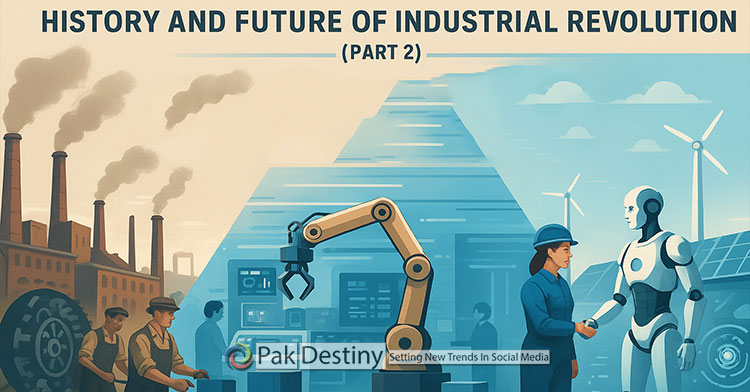
Industry 5.0: The Sequence of Smart Factories.
In Part 1, we discussed the history of the Industrial Revolutions—from the industry 1.0 to the Industry 5.0. Now, it’s time to focus on the current transformation: Industry 5.0.
What is Industry 5.0?
One of the key advantages of machines and bots is that they operate without fear or greed—traits that often influence human decisions, especially in corporate environments. Human errors, biases, and misjudgments, frequently driven by fear or personal gain, result from limited or unreliable information.
Industry 5.0 is about the extensive collaboration
between Managers and Machines. Each industrial revolution has aimed to improve decision-making by enabling access to unbiased, real-time data. Systems have been designed to leverage this data to achieve maximum efficiency and effectiveness.
Examples:
- At an airport, an AI-based immigration counter uses biometric data like eye scans and travel history to minimize the risk of human error or manipulation.
- In a factory, a biometric attendance system ensures objective timekeeping—removing reliance on human judgment that could result in errors, intentional or not, such as incorrect salary deductions or staff dissatisfaction.
The Goals of Industry 5.0:
The ultimate objectives of any industry remain consistent:
- Enhance productivity
- Empowering Responsible consumption with sustainable customisation.
- Ensure sustainability
- Improve product quality
- Reduce costs and delivery times
Executives and managers continuously strive to improve production lines, define KPIs (Key
Performance Indicators), and monitor performance. In Industry 5.0, humans and machines collaborate, rather than compete, to reach these goals.
While intelligent machines can process data and perform repetitive tasks with near-perfect accuracy, human ingenuity—creativity, intuition, and ethical reasoning—remains irreplaceable. In this revolution, both humans and machines coexist, complementing each other.
Benefits of Industry 5.0:
- Machines handle repetitive, error-prone tasks.
- Bots draw insights from massive global datasets.
- Human workers become more focused, productive, and empowered.
- The result: higher industrial productivity with reduced human error.
Of course, like all revolutions, Industry 5.0 has its benefits and drawbacks, which we will explore later. First, let’s understand the sequence and functionality of Smart 5.0 Factories.
Sequence of Smart 5.0 Factories is as follows:
- MIS (Management Information System) based on Real time data and End to End Visibility of whole Value Chain.
- Human and/or AI based Data-Processing and Decision Making systems for Optimisation of Efficiency And productivity.
- Implementation of Automation of Systems when manual systems have reached to the level of maximum Optimisation.
- Human and Machine Interaction and Collaboration to improve industrial efficiency in an endless loop of Improvement.
- Enhancement of Profitability for the Corporation and Creation of an exquisitely harmonised Society 5.0
Phase 1: Real-Time Data Collection:
Decisions are always based on data and logic. The more authentic, accurate, and real-time the data is, the more logical the decision-making becomes. IoT (Internet of Things) has revolutionised data collection systems. Industrial IoT integrates with every machine, cost centre, employee, and system across the value chain, manufacturing, and sales to collect real-time Big Data. Big Data Analytics systems organise large volumes of data and convert them into actionable information to extract KPIs (Key Performance Indicators) and KGIs (Key Goal Indicators) for efficient and effective decision-making. This creates a continuous information system based on real-time connectivity and end-to-end visibility of the entire value chain.
Big Data is not limited to physical space—it can be saved in the Cloud for greater visibility, breaking communication barriers, increasing openness, and eliminating the outdated linear nature of supply chains. This enables remote accessibility and retrieval. The Cloud has become a central repository for data, offering a single source of truth and rapid access to information across the board. However, the presence of
such massive real-time data introduces the threat of system breaches, which highlights the critical importance of cybersecurity.
Phase 2: Big Data Processing and Decision-Making Systems:
The expansion of civilisations began when human beings started collecting, writing, and retrieving data, which was previously limited by human memory. Until very recently, managers struggled to manage vast data volumes using various software tools and ERP (Enterprise Resource Planning) systems. MDS (Management Data Systems), such as NASA’s digital walls with graphical displays, are becoming outdated due to the sheer amount of data and the difficulty of interpreting it into actionable decisions.
With the invention of AI bots and their integration with highly efficient ERP systems, managers can now convert Big Data into concise, smart action plans that are both achievable and measurable. AI-assisted Big Data can now be used to optimise machines by
reprogramming processes for continuous learning and improvement.
Big and real-time data also enable better warehouse management—for raw materials, finished goods, and in-process transfers—using technologies like RFID and RTLS. These can be integrated with ERP systems to ensure full visibility and better planning.
Historical Big Data can be used to reduce or eliminate forecasting errors. Advanced algorithms based on a company’s past demand and supply patterns improve forecasting accuracy, helping to avoid bullwhip effects in the supply chain. Example: Restaurants using AI to process data of existing customer base, historic sales over the years, combined with weather forecasts and change in demographics of area to support decision about the menu and batch sizes to produce.
Phase 3: Implementation of Automation:
Once data is available in a processed and actionable form, managers make informed decisions to improve quality, reduce costs and delivery times, and integrate
horizontal and vertical systems across the value chain. The primary objective is to improve systems that require no investment in machines, human resources, or materials. Systems are redesigned to optimise resources such as HR, space, inventory, and energy by eliminating all types of waste through techniques and cultural changes within the organisation.
Smart investments in automation and system improvements are made once initial optimisation has reached its limit. Automation can be implemented in ordering systems via ERP, in warehouse stacking and retrieval according to order status, and in operations and production processes. Material movement between departments—from raw material storage to production, and then to finished goods after automated packing and labelling—can be automated to maximise efficiency and productivity.
In the fifth industrial revolution, automation is not limited to operational excellence, material handling, or waste (MUDA) elimination. It also enhances quality inspections, control processes, and traceability of weak links, enabling more efficient planning through accountability, positive reinforcement, or training.
Phase 4: Endless Loop of Improvement:
Improvement is not a fixed goal—it is an endless loop. As one bottleneck in the system is resolved, new ones emerge, requiring continuous attention for further enhancement. Improvement is not limited to operations, systems, material movement, or quality control. It also includes experimenting with new and better raw materials and testing innovative production methods.
Scientists and industries are continuously discovering raw materials that are more process-efficient, environmentally sustainable, and cost-effective for both producers and consumers. Many of these materials are designed to reduce the use of natural resources like energy and water, making production more sustainable.
New technologies are also replacing conventional manufacturing techniques. For example, additive manufacturing (3D printing), which produces objects layer by layer, is revolutionising industries such as
aerospace, automotive, medical, agriculture, textile, and construction.
AI-driven machines can now communicate bi- directionally with their managers and collaborate with international departments and businesses. This unprecedented connectivity enables deeper analysis, transparency, and enhanced efficiency through a continuous loop of information and decision-making.
Augmented Reality (AR) is an emerging technology with various applications in the endless loop of improvement:
- Designing and executing extensive training and maintenance programs
- Training new employees on virtual machines to reduce learning curve costs
- Providing workers and managers with real- time tips and service manuals
- Enabling human learning of machine systems without disassembly
Phase 5: Profitability and Establishment of Society 5.0:
The ultimate goal of Industry 5.0 is to create a sustainable and socially beneficial society, referred to as Society 5.0. Human and robot interaction in Industry
5.0 allows the entire society to access goods and services that offer greater value to both consumers and producers—a true win-win scenario.
Most importantly, Industry 5.0 ensures that Mother Earth is protected throughout the value chain. The aim is to make systems more efficient and value-driven, yet highly sustainable through:
- Green buildings
- Renewable energy sources
- Sustainable raw materials
- Environmentally friendly production processes
All of these contribute to achieving the Sustainable Development Goals (SDGs) established by the United Nations in 2015.
Ideally, the successful implementation of Industry
5.0 will help eliminate hunger and poverty, ensure clean water and sanitation, reduce inequality, stimulate economic growth, promote responsible consumption and production, and foster peace, justice, and an overall improved quality of life— creating Society 5.0.
The future of industries is dynamic and fascinating. New technologies are emerging every day. Instead of resisting these changes, it’s time to embrace Industry 5.0.
Cobots (collaborative robots) are the future of industry. They are no longer futuristic—they are becoming increasingly present in the workplace. Designed to work alongside humans in shared workspaces, cobots perform tasks with precision, learn what to do next, and recognise human presence and touch.
They adhere to safety and risk protocols, detecting, comprehending, and responding to human actions. Cobots understand human intentions and support workers accordingly. Their apprentices observe and learn how humans work.
Like any technological leap, cobots bring certain fears and risks. The million-dollar question remains: Will humans stay relevant in a world with cobots—or is this leap leading us toward a catastrophic conclusion?

About Author
Rana Sohail Ahmad, a multifaceted author, entrepreneur, and philanthropist. With a background in Engineering and Business Administration, he’s the founder and CEO of Four thriving Global companies. Beyond his professional success, Rana is deeply interested in psychology, history, Technology and social sciences. He’s also an avid cyclist, yoga instructor, and health trainer. However, his most significant endeavor is the Quest of Happiness Foundation (QHF), which he founded to spread happiness and well-being. QHF conducts workshops on happiness, physical health, and career planning, especially for teenagers and university graduates, while also taking part in social initiatives like cleaning and plantation campaigns. Rana Sohail Ahmad’s upcoming book offers a unique blend of personal growth, and social responsibility, all centered around the theme of happiness with scientific and management practices.

